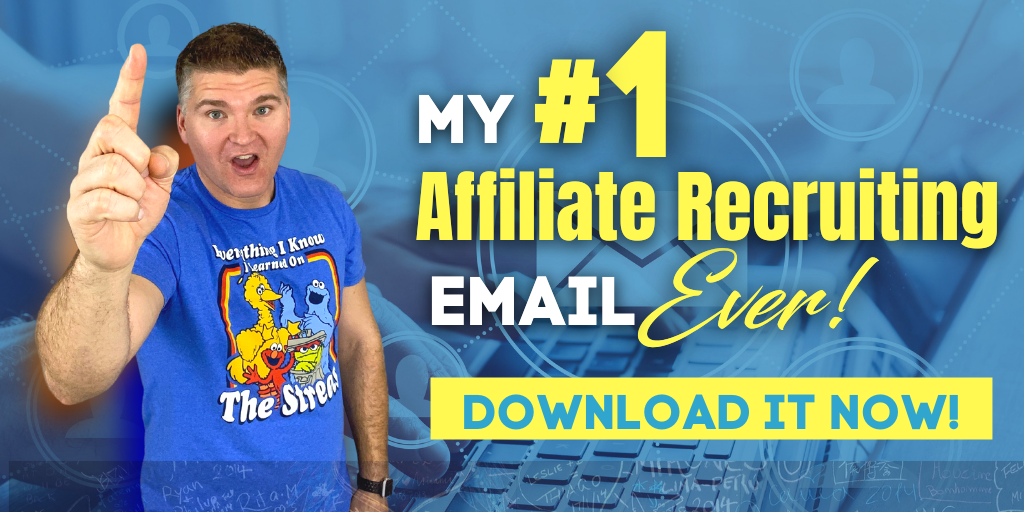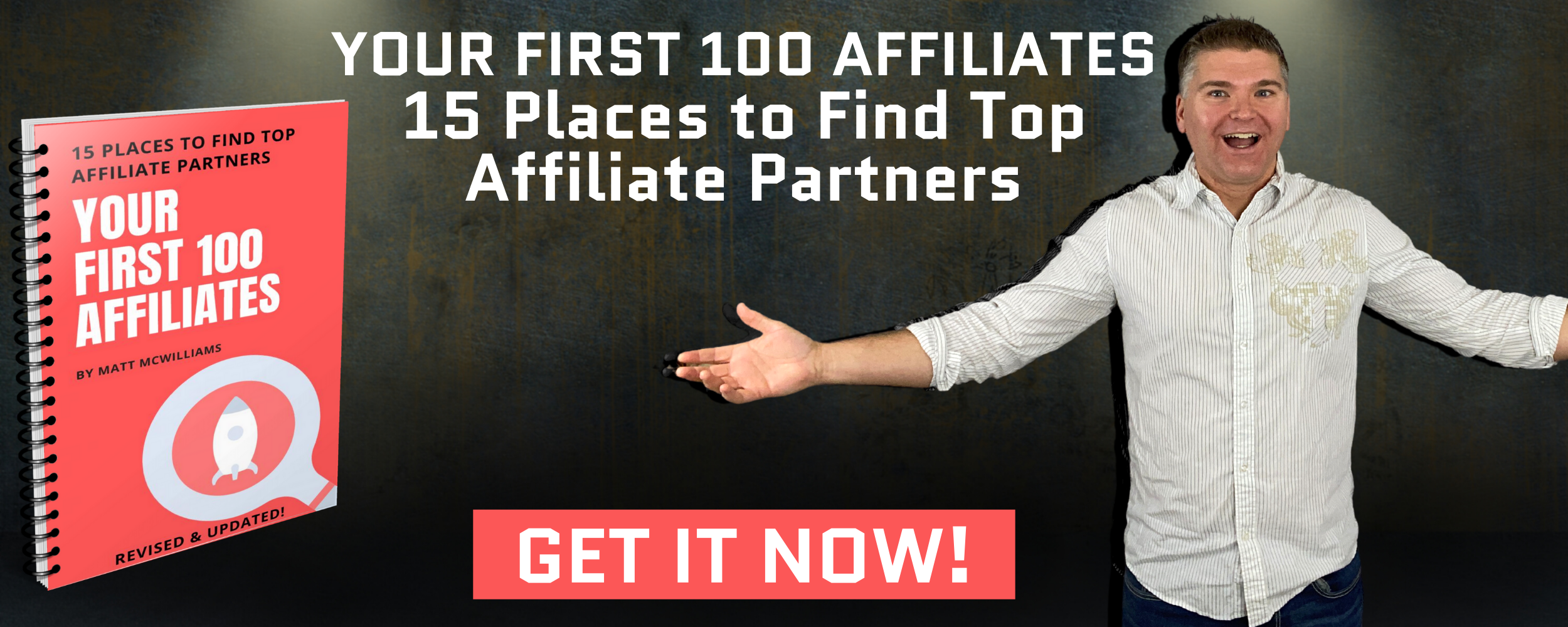Finding and recruiting affiliates is not complicated. But there are five things you can do (or not do) to really make it difficult…and even destroy your efforts. Today, I’ll share what the most common killer mistakes are and how to avoid them.
Click Here for The Written Transcript of This Episode
Need help activating your affiliates? Use my proven email templates for getting inactive affiliates in the game and making sales! Get them here!
Links Mentioned in this Episode
Get My #1 Affiliate Recruiting Email
Most Common Affiliate Program Mistakes (and How to Avoid Them)
Text me at 260-217-4619
Don’t Miss An Episode – Subscribe Below
Previous Episodes of The Affiliate Guy
Behind-the-Scenes on Our Affiliate Promotion for Product Launch Formula
How to Promote Virtual Summits as an Affiliate (If You Aren’t a Speaker)
Fix Your Funnel: How to Increase Sales and Make Your Affiliates More Money with John Ainsworth
Affiliate Marketing Lesson: Shifting From Promoting Free Content To A Paid Product
Book Launch Party: An Interview with Matt About Turn Your Passions Into Profits
Special Episode: Highlights from My Whirlwind Book Tour
Top 5 Biggest Affiliate Recruiting Mistakes
Finding and recruiting affiliates is not complicated.
There are five things you can do or not do to really make it difficult and even destroy your efforts.
Today, I’ll share what the most common killer mistakes are and how to avoid them.
So today I’m sharing the top five affiliate recruiting mistakes. Now, I’m assuming that you’re listening to this so that you don’t make them.
The reality is that recruiting affiliates, it’s not that hard. I wish it was a lot harder.
If it were harder, then what I do would be considered like totally ninja stuff and I’d make a lot more money.
But when you know the system and I’m going to share some of that system today, it’s not that complicated.
I started my first affiliate program back in 2005, and when I did that, I knew literally nothing, literally nothing about recruiting affiliates.
I knew nothing about how to find affiliates, how to get them to say yes, what kind of emails to send, how to run an affiliate program at all, really, for that matter, through a lot of trial and error, some massive mistakes.
Hopefully, or thankfully, none of them were killer mistakes. Our affiliate program was able to do a little bit over about 18 months later. We’re doing over a million dollars a month.
The thing is, I have personally made every single mistake that I’m sharing in this episode. Every single one of them.
I’ve personally made some of them multiple times, and some of them were nearly fatal. Like I said, none of them were. Some of them were nearly fatal to our affiliate program, to our business at the time.
But the good news is you don’t have to make those same mistakes. You don’t have to make any of the mistakes I’m sharing today because I want to share what they are and how to avoid them.
I screwed up a lot. I said this so many times. Like, most of what I share is stuff that I did through trial and error. I made these mistakes.
Sometimes it was because I tried something and it worked. That’s pretty cool. Sometimes I share things that aren’t mistakes, but things that I actually did well. But of course, when you try a lot of things, you’re going to make a lot of mistakes.
These mistakes have cost me millions of dollars, to be clear. Now, the good news to that is I get to help you avoid them. Yay. You kind of suck to have to have made them myself. But at least I get to help you avoid them.
So 18 years ago, it’s crazy. 18 years ago. Oh, my gosh, 18 years ago is such a long time. We’re almost at 20 years two years from now, I’ll be telling this story. It will be 20 years ago.
My business was facing a crisis not unlike the situation you might be in today. We had this great idea. We had all the right intentions, we had the right team in place, but we had just basically, we’re about to go bankrupt.
Now this was 18 years ago, not today. And we’re about to go bankrupt because we’d spent most of our money on banner ads.
And I remember this feeling like it was yesterday. We kind of all stood there. It was Memorial Day week in 2005, and we kind of stared at each other like, how in the heck are we ever going to recover from this?
And we didn’t have enough money to go out and compete with our competitors at their level.
They were all publicly traded companies. They’d been around for years, and we were the new kid on the block. We were broke.
Now, years later, fast forward to the late two thousands. After we had discovered the solution, I began to work with other businesses who faced these similar problems.
They might be on the verge of bankruptcy, or maybe they were just tired of the stagnant growth that comes from so much the marketing these days.
It kind of seems like that’s when people call me when they’re in crisis or they just reached the point where they were tired of mediocrity.
Now, the solution for us 18 years ago was to start an affiliate program. Like I said earlier, I mean, that grew over a million dollars a month in less than two years.
And when I first started, I had this brilliant idea to start an affiliate program, and we were all excited. We’re like, yes, this is going to change the world.
And our CEO looks at me and like, where do we actually find affiliates? I’m like, oh, my gosh, talk about sucking the air out of the room. Like we had no idea.
That’s been my mission for the last 18 years or so. Finding, recruiting, serving, motivating, and growing affiliates. And for me now, the cool thing is I get to teach other people how to do this.
We get to do this for other companies. Like, at the time, I was just doing it for my company, and now we get to do this for other companies.
Now, the competition, they want you to think that you need to wait to start your own affiliate.
They want you to think that having affiliates, that’s only for the cool kids, for the insiders, right? They are wrong.
Now, they have their own reasons for making you want to think those things, but they are not true.
So if you’ve ever seen people, you’ve seen the launches, right? They’re doing a million dollars, $10 million, whatever, and everyone on earth that seems is promoting them.
And you thought like, Can I do that? The answer is yes, you can. You can do that. All right, you can do this.
I didn’t have a playbook. No one was doing these types of lessons. I just made it up.
But today I’m going to share how I screwed up, how to avoid those mistakes, what to do instead.
So what are those top five mistakes that most people make when recruiting affiliates?
Well, number one, waiting too long to reach out.
If you’ve got a book launch, you’ve got a product launch, you’ve got a summit, you’ve got a time bound challenge.
You need to be recruiting at least six months out. Really? Nine months out.
Get my #1 affiliate recruiting email (the one I’ve personally used to recruit thousands of affiliates in dozens of niches). Grab your copy here!
Now, the reason for this is very simple. When you think of the way that most people structure their content calendars, most people plan at least a quarter in advance.
So if you’re in Q One, regardless of whether you’re in January, February, or March, most people will have their April, May, and June somewhat planned out, if not fully planned out.
I know for us as a company, this is the least in advance that we’ve been planned out in ages.
I’m just coming off my big book launch, and we got, like, six months ahead, what, like, five months ago.
Now we’re only like, a month and a half ahead. And so normally, though, we’re six months ahead. Think about that.
If you’re in Q One, let’s say you’re in the middle of Q One, you’re definitely not getting anybody to commit, or very few people to commit to promoting you in Q Two.
And then they might even be planned two quarters in advance. So if you do nine months out, you’re virtually guaranteed to get on their promo calendar.
You can’t expect people just to drop everything to promote you. That’s the thing. They’re not going to.
So there’s a compromise. Like, yeah, ideally we’d plan this two years out. Of course, nobody has anything on their calendar. Two years from now, you can get on.
There’s a compromise between being ridiculous and never launching and saying, okay, we’re going to try to get this at least six months out.
So if you’re listening to this in May, then you need to be recruiting for Q Four. If you’re listening to this in February, you need to be recruiting for Q Three.
That’s the compromise there minimum. Six months out. Again, five months if the quarters fall in a certain way, doesn’t mean that you can’t do longer.
Hey, you’re eight months away. Great start. Now, that’s the thing. Start out.
One of the reasons why I did so well with my book launch is I was recruiting people I launched in January of 2023.
I was recruiting people in mid-2021, in the middle of 2021. I was recruiting people to write endorsements for the book, to promote the book.
At least seeding that early on. Now, if you’ve only got 47 days before your launch, that doesn’t mean you don’t reach out.
You just need to understand that the results are going to be smaller. Okay?
You need to temper your expectations because you’re not going to probably do some massive launch if you’re just starting 47 days out or whatever.
Mistake number two, limiting the types of affiliates that you recruit. Now, this means not working with certain types of affiliates.
Now, some of these types of affiliates I’m going to list might not be right for you, but for most programs, these can work.
And I’m going to give you some examples here, like Co-Registration Affiliates, Co Reg Affiliates.
These are people that are promoting other products, and then they promote your offer in conjunction with their offer.
So this is done a lot of times, like on lead generation niches, but it can be done with all kinds of different products.
And I’ll just give you an example. When I was in the insurance industry, this is that very first affiliate program 18 years ago, some of our top affiliates were mortgage companies.
And these mortgage companies would say, hey, you’re applying for a mortgage, and you fill out the application.
We already know all the information, basically, that we need to know for homeowner’s insurance.
So check this box and then answer a few additional questions to get information about homeowners insurance.
If you’re applying for a mortgage, you’re a perfect candidate for shopping for homeowners insurance.
The reality is, I would venture to say that 50% of homeowners insurance shopping is done on new home purchases.
I’m not saying that people never shop their home insurance. Like, we’re getting ready to shop our home insurance because it’s been ten years, and we just kind of, like, wonder what we could if we could save a few hundred bucks a year, why not?
But it’s been ten years. That’s my point there. But when we were first shop, like, getting a house, yeah, that’s when we shopped.
And they were great leads because we got the perfect people. We got all the information.
The key for us was making sure they filled out a few other pieces of information. So we didn’t make it too easy for them.
So I think we had, like, four additional questions we asked that they didn’t ask on the mortgage application.
And then we got that whole lead to be able to sell to our agents. So co-reg Affiliates can be great Affiliates.
Coupon Affiliates.
These are exactly what they sound like. Affiliates who promote deals and coupons to their audiences.
These are sites that cater to customers who are looking for a discount or sale.
Now, to be clear, if you don’t currently have coupons or discounts available for products, I am not saying that you need to create coupons just to use this type of affiliate, all right?
Some products should never be discounted. Like, our courses, for example, are not discounted that cheapens the brand.
But if you do have coupons or discounts, you definitely want to use these affiliates.
Now, a lot of people are like, I don’t want to have coupon affiliates, so I don’t want people going to look for finding these deals or whatever.
Again, they cater to people who are looking for discounts or deals. They’re not, like, overriding your stuff.
Generally speaking, that’s not what the researchers found. Their audience are the types of people that if they see a discount, jump on it.
You could argue that that’s an irrational way to buy things, but it is what it is.
I’m not trying to change people’s psychology of how they buy stuff. I’m trying to tap into it and utilize it, take advantage of it.
And so if they’re the type of person who’s looking for a deal and they will buy your thing, that’s normally $100, and it’s discounted to $80 because of a discount, and that causes them to buy.
Would you rather have them buy two things at $80 or zero things at 100? What’s the math on that? Right?
Yeah, I’m not a genius, but any number times zero is, well, zero. So just think about that.
So if you have coupons, you definitely want to use coupon affiliates. Now, loyalty affiliates, some people call them incentive affiliates.
These can also be very effective affiliates. They’re called loyalty affiliates for a reason.
The people they reach are very loyal to them. So, like, rebates, right? My wife uses Ebates, so we travel a ton for our business, for pleasure, for our kids, soccer. I don’t even know. I’m not even talking about houses.
We stay in houses a lot when we travel for longer vacations, but we’re in hotels 80 nights a year, probably.
And she uses eBay, and we get like, I don’t know. I don’t know how much money you have to ask her.
I have no idea how much money we get, but I know it’s thousands of dollars a year that we get back, pretty much all from major purchases.
And so basically, if someone purchases a product, they get, say, a $10 cash incentive back. Ebates in this case is the affiliate.
So they might make $15 for referring the business. They give ten of them back.
And so that encourages their loyal subscribers to purchase through them, with the reward being that the customer gets a percentage back.
And essentially, the affiliate, as I said, has taken part of their affiliate commission, giving it back to the consumer as a cashback incentive.
So, again, if this doesn’t fit your program, don’t do it. But if you do have opportunities to work with loyalty affiliates and coupon affiliates could be very good nonprofit affiliates.
These are charitable organizations. PTOs, parent-teacher organizations, and people who use affiliate promotions as a fundraiser for their organization.
And essentially they tell the organization that a percentage of each purchase, their affiliate commission is donated to the organization.
Now, if you don’t think nonprofits can be effective and profitable when I worked just know when I worked with Shutterfly’s affiliate program, the first year that we built the nonprofit program, we did more than $8 million in sales.
If you are ready to take your business to the next level and start an affiliate program, start with my free report, Your First 100 Affiliates. This report takes nearly two decades of experience, trial and error, and lessons learned about finding top affiliates in nearly every conceivable niche and puts them all into one report. Grab your copy here!
That’s the first year. I’m just going to leave that at that. I don’t know how much they’re doing today.
That was a decade ago. We did 8 million the first year. We barely built that thing up.
So there are tons of different types of affiliates. Pay-per-call affiliates, retargeting affiliates.
If you want to know all of the places to find affiliates, go get my report. Your FIRST 100 affiliates. MattMcWilliams.com/FIRST100.
I’ll put that in the show notes as well. I’ve got all the stuff listed there.
But the gist here is like, don’t make the mistake of limiting the types of affiliates that you recruit.
I only got to have people who are just like me or I don’t want whatever. Maybe like saying, I only want men as affiliates.
I can see a couple of niches where that might be relevant, but in most niches, it’s not. It’s a ridiculous way of doing business.
So don’t limit who you can possibly work with.
Number three. Now, this might seem counter to what I just shared, but it’s not focusing on one type of affiliate to start.
All right, so the best way to explain this is to kind of explain a little bit of my story, I took over the affiliate program for Shutterfly back in 2011, and we were looking to get into working with different types of affiliates.
And the CEO at the time basically was like, hey, we want to get mommy bloggers, and we want to get photographers, and we want to get these nonprofits.
We want to get schools and hospitals and loyalty sites and all the stuff I just talked about, right?
Like, how is this different? I was like, Whoa, let’s slow down. What do we need to do, Do we need to pick one type of affiliate?
And I want to dominate that niche for the next six months to a year. And I decided that it was going to be mommy bloggers.
I earned the nickname, like, a year later, king of the Mommy Bloggers.
It’s kind of weird, and I realize that mommy bloggers don’t want to be called mommy bloggers, but that was what we called them.
And it was like, mommy blogs, right? And so we want to dominate that for about a year.
So we went out, and only types of affiliates we actively recruited, did we have others who came to us? Absolutely.
Did we accept them? Sure. The only types of affiliates we actively recruited were mommy bloggers.
We focused on getting them left and right, left. And I mean, just every day, like, boom, 1020, 30, 40 new mommy bloggers.
We’re going to get them to sign up. We’re going to get them promoted.
We incentivize him. We went crazy getting them.
And it got to the point where after about seven months, we had like a few thousand mommy bloggers who were in this affiliate program.
And it got to the point where we the end of like six, seven months, we had probably three 4000 mommy bloggers in this affiliate program.
And it got to the point where literally, it was like, if you started a mommy blog, like, step one, register your domain.
Step two, set up WordPress. Step three, sign up for the Shutterfly affiliate program. And why do we do this?
Why does this work? Because mommy bloggers follow other mommy bloggers.
Photographers follow other photographers. Wedding photographers follow other wedding photographers.
Nonprofits follow what other nonprofits are doing. And if you can get in, like, think about it.
If there are 5000 types of people in there and it’s 5000 mommy bloggers, right, and you have ten of them promoting you, there’s a pretty good chance that the 5001st mommy blogger who signs up isn’t following any of those ten.
But if you have a thousand of them, it’s almost impossible that they’re not following at least one of them.
And actually what starts to happen is it gets to the point where they’re following numerous people, and it seems like you’re everywhere.
And then they start to come to you. For those first four or 500 monuments that we recruited, we work our butts off to recruit them.
Hours for each one. That’s probably at least 2 hours on each of the first 500,000 hours collectively between our team.
We busted it months later. They were just coming to us in droves. And then from there, we went to photographers first.
Went to the photographers and said to the photographers, like, boom, we focused on wedding photographers, and we got all of them to sign up.
And then it was like portrait photographers. They came to us, and then we went to the nonprofits.
And even within the nonprofits, we first focused on children’s hospitals. And then we went from there and focused on other types of nonprofits.
And then we went to PTOs and PTAs. And yeah, it sped up each time because we began to get some more organic growth in them just coming to us. But that’s how we did it.
We focused on one type of affiliate to start and one type of affiliate at a time for the first couple of years. And it requires discipline to do that and you just got to go all in on that one type.
The fourth mistake sending a first message, a first reach out the message that is too dang Long when I first started reaching out to affiliates, I sent these long verbose emails with all sorts of details here’s about our company and blah, blah, blah.
Here are some stats and here are some links. And you’ll go read this and all that stuff.
Totally wrong way to do it. No one reads them.
So we have a goal in our company or a rule in our company. We call it the four-sentence rule.
Now, occasionally, I’ll let us clients use a fifth sentence, but the key here is to make your initial contact short three, four, or five sentences.
Your goal is not to get a yes response right away. It is not to share everything with them about your product or your program.
Your goal is simply to inspire enough curiosity. They write back with the three magic words. Tell me more.
If you want to get a copy of my number one affiliate recruiting email, my number one email for finding affiliates, just go to MattMcWilliams.Com/bestemail.
And I’ve got my number one affiliate recruiting email there. You can get it for free at that URL.
So we’ll put that in the show notes as well. The key, as you’ll see, is it’s a short and sweet one.
I’m not trying to get them to go, oh, my goodness, I have to promote this. Yes, please sign me up.
No, it’s like the kind of go, yeah, well, interested? Tell me more, or can you send me more info?
That’s all we want in that first email that invites me to write it. Now, I sent them a four or five sentences first email.
Now the next one, I can write 8910 sentences, and then they respond back and say, sign me up.
Now, I can send them longer emails saying, here’s the promotional material, but if you try to send all that stuff in the first one, it’s not going to get red.
The other thing is links lower deliverability. So if you got links, don’t include those.
Shorter emails are more likely to be delivered. Unformatted emails are more likely to be delivered.
So keep it simple in that first email and then the last one, the last mistake, mistake number five, one that I made early on but quickly remedied.
Number one, there are kind of two mistakes tied in together. Not inviting customers to become affiliates and avoiding those smaller affiliates.
This first one, not inviting your customers. This is something our clients get.
We have a new client, Shane Sam from Flipped Lifestyle. I mean, this guy gets it.
He reaches out to us, and he’s like, I want you to do for me what you’ve done for these other clients.
Like, they’ve referred him to us, and he said, I get it. Like, we’re going to start with my customers.
We’re going to start with my audience. We’re going to start with the people who know, like, and trust me.
We’re going to start with the people that have an intimate knowledge of my product and a personal success story army and they’re going to defend me, and we’re going to build an army of those affiliates.
He’s like, I know that they’re not big. They don’t have 20,000 people on their list.
They’re not going to make thousands of sales individually or even tens of sales individually.
He’s like, I know that most of them are going to make one, two, three sales when we add them up. We’re going to build an army.
And he even named we have a slack channel. He’s the one that named it. It’s called the affiliate army.
It’s what I’ve talked about so often, right? What better source of promotional partners, what better source of affiliates than your customers?
Most people never do this, though. As I said, they have a piece of intimate knowledge.
They have a success story. They know, like, and trust you. They’ll defend you.
You couldn’t ask for better promoters. And part of the reason why people don’t do this is that these affiliates are typically small.
We all want the big whale affiliate, right? We want oh, man, if I’m going to sell a book, I got to get on Oprah.
Why not just go on 100 other podcasts that are more targeted to your niche anyway?
You don’t need to be on Oprah. We all want that big whale affiliate. That’s not how I built it.
I said earlier, I built my first affiliate program with over a million dollars a month in 18 months.
I didn’t build it on whales. I built it on a lot of small affiliates. I built it on a lot of small affiliates.
Brandon Miller still remembers the height of my edit’s brand, and he was from western North Carolina.
If he called me up today, I recognize his voice. Made a couple of $100.
Never made more than a couple of thousand in a month. Wasn’t a big affiliate.
I was told that working with small affiliates isn’t worth the time. Rather than have 100 small affiliates each making a few sales, we wanted to go get four or five affiliates who make hundreds of sales.
Now, there are three problems with this strategy. Number one, you put all your eggs in a few baskets, all right?
You put all your eggs in just a few baskets, you get five big affiliates, and one of them quits.
You just lost 20% of your sales. That kind of sucks.
You have 1000 small affiliates, and you lose 20 affiliates. Oh, well, 2%, you can live with that 20%.
Number two, you miss out on growing those smaller affiliates who remain loyal for life.
I’ve shared it so many times. Like, you have 100 small affiliates.
You fast forward three, four years from now, a couple of those affiliates, most of the affiliates will be about the same size, maybe twice as big.
So they’re going to go from making two to four sales. Hey, having 50 people go from two to four sales, that’s not a bad deal.
A few of them are going to be out of business. They’re going to go from making one sale to no sales.
A few of them are going to be about the same size. A few of them are going to triple the ten X.
They’re going to go from making two sales to 15 sales. Hey, that’s pretty cool.
But five, six, seven of them are gonna hit it huge. They’re gonna be 100 times bigger, 200 times bigger.
And they will always remember that you are the one who gave him a chance. There’s a reason why I just was on onyxingal show. Onyx is huge today. Multiple eight-figure businesses.
You know why I’m friends with onyx and gal, and I get to be on his show and talk about my book and talk about how we launch the book and do all kinds of cool things with Onyx and why he’s like, I’m going to work with your company to run my book. Launch it. Because 17 years ago, he was a small affiliate for me, and I treated him like he was a rock star.
Nobody knew who he was. He still remembers that.
So, number two, you miss out on those small affiliates. And the third problem is, you miss out on the chances to test things.
One of the things that you can do with small affiliates is run some tests.
Start off with those small affiliates. Run some tests, try some things. They act like guinea pigs.
So we’re doing this with our clients. Like, we’re just trying a few things, and sometimes it works, and sometimes it doesn’t.
But we learn. We make small mistakes. So the solution here works with those smaller affiliates. Train them.
Share what’s working with them. Build this army of loyal evangelists.
Invite your customers. Train them, nurture them. Build that army. Build your affiliate army, your customer army.
So number one, a mistake waiting too long to reach out. Start a minimum of six months out.
Number two, limiting the types of affiliates you recruit.
Need help activating your affiliates? Use my proven email templates for getting inactive affiliates in the game and making sales! Get them here!
Try working with some co-reg affiliates or coupon affiliates or nonprofits or pay-per-call or retargeting affiliates.
Go grab that report at Matt McWilliams ComFirst 10 zero first 100, your 1st 100 affiliates, and find some different places to get affiliates.
Number three, not focusing on that one type to start, though. Just because you’re going to try some different types doesn’t mean early on that you don’t start with one type.
Doesn’t matter what type it is or what niche it is, niche it down and really dial in and get your messaging and work with those types of affiliates to start.
Number four mistake is sending that first message, it’s too long. So go grab the template. MattMcWilliams.Com/bestemail grab your template.
And number five, not inviting your customers to become affiliates and avoiding working with those smaller affiliates.
Instead, build that affiliate army. So hey, I’d love to hear from you. Your biggest takeaway. Make sure you text me at 260-217-4619.
We’ll put that number in the show notes as well. Text me and just let me know what your biggest takeaway was. I’d love to hear from you.
Like, which of these five is going to be the mistake you’re going to focus on not making over the next few months?
I’ve got links in the show notes again to my best affiliate email recruiting email.
My number one affiliate recruiting email. Your 1st 100 affiliates report.
We got links to find affiliates now if you want to go check that out and make sure you hit subscribe so you don’t miss the next episode. How to create recurring affiliate revenue promoting membership site.
So we’re going to talk about we talked a few some number of episodes ago about how to run an affiliate program for membership sites, where we’re going to talk about now how to promote membership sites and create that monthly revenue, which is super awesome even if it’s just a few hundred dollars.
Like when you have it coming in every single month, I know we get PayPal deposits.
Now we have multiple things and some of them are over. I think we have a couple that is consistently over $1,000.
We don’t have any that are much over a monthly revenue. In fact, I think we only have two and neither one of them is over 13 or 1400 bucks.
But we have a bunch. Like we have like seven or eight, nine things that are between 200 and $600.00.
But when you add that up, it’s like, man, we’re getting five $6,000 just every month recurring and it goes up.
It seems like every quarter, like the $400.01 will go up, you know, like $15, $20, something like that.
Some of the other ones are going up and it’s like, that’s just like our floor. We could literally do nothing and sell nothing of our own and we’ll just make like $6,000 next month. Now that pays for like one team member.
But still, my point is it’s nice when, you know, especially if you’re a solopreneur or have a small team, you can have a nice little floor of a few thousand dollars doing nothing. Pretty cool.
So that’s what we’re going to talk about in the next episode, how to create that recurring revenue promoting like monthly and other recurring membership sites.
So make sure you hit subscribe so you don’t miss that one. I’ll see you in the next episode.
Thank you so much for listening today.
Questions?
Text me anytime at (260) 217-4619.
Or…check out some of my free reports to help you get on the right track:
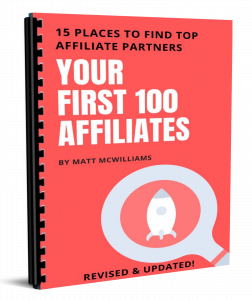 |
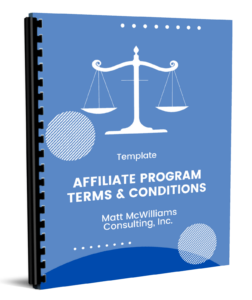 |
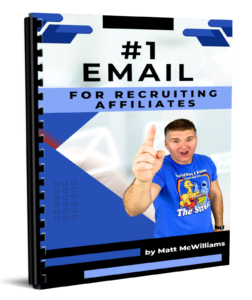 |
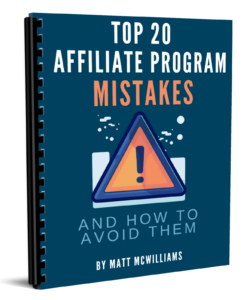 |
 |
 |
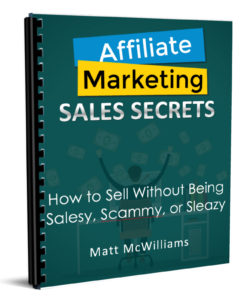 |
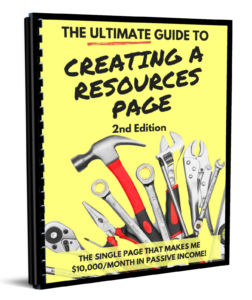 |
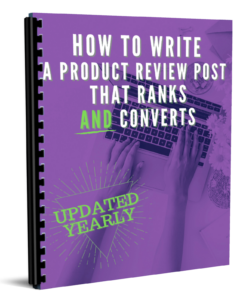 |

